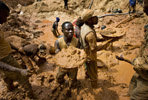
When debating the merits of the argument for a more rigorous tracing and auditing system for conflict minerals originating in Congo, one need not look any further than Rwanda to understand the necessity. Rwanda has no large-scale mining industry, and several NGO and aid agency sources say a significant part of the country’s minerals exports—its largest export sector accounting for over 35 percent of total annual export earnings—are smuggled from Congo’s mineral-rich North Kivu province, which has strong social and economic links with elements of Rwandese society.
The Rwanda Geology and Mines Authority, or OGMIR, has touted a recent pilot project using scientific analysis of ore composition to certify the origin of conflict minerals as an “advanced…process of certifying mineral supply chains and upgrading mineral extraction to good practice standards universally accepted.” This initiative is not as helpful as the OGMIR makes it out to be. At best it is one step forward on a much longer path, but certainly not the final one. No evidence has been shown that microscopic analysis of ore composition would allow minerals sourced in Africa’s Great Lakes region to be traced back to the mine of origin—for starters, simply mixing ores from various locations could confound the whole process. A more comprehensive certification process is necessary to ensure that minerals exported from countries like Rwanda are not originating from militarized mines in eastern Congo.
Smuggling of materials from eastern Congo to neighboring countries like Rwanda for export is all too easy. The current U.S. legislation is also just one step toward certification of conflict-free products and a minerals trade that benefits the Congolese people. Achieving the transparency necessary for certification will require more than a handful of companies in Rwanda “volunteering” to have their mineral ore audited for composition. Input from a combination of companies, governments, and consumers to create a transparent, rigorous, and credible system of certification that is able to trace through both human and scientific systems is necessary. We have suggested starting with a framework of tracing, auditing, and certifying for companies and countries to prove their mineral supplies are conflict-free.
As the situation exists today, there is no way governments in the Great Lakes region can ensure that all conflict minerals originating from any respective country are “accounted for” and “mined with international good practice,” as OGMIR suggests its pilot program would do. We have no legitimate method of knowing for sure whether these minerals exported from neighboring countries like Rwanda passed through the hands of armed groups in Congo or whether they came from another source. That is why we need more definitive proof from a transparent trace, audit, and certify system.
Through the recently passed U.S. legislation, the Securities and Exchange Commission, or SEC, has nine months to write regulations regarding the disclosure of conflict minerals from the Congo and its adjoining countries. From that point, companies would then have almost an entire year to meet their first reporting requirements, putting the initial reporting period sometime around January 2012. In addition, the U.S. government, international NGOs, and partners from the region have been working to establish certification schemes for the past two years. The writing has clearly been on the wall that regulatory reform was on the way. Therefore, it is difficult to argue, as the OGMIR has, that the timing for implementation is sudden and was not clearly studied to avoid hurting the mining industry in the region.
Countries such as Rwanda are inexorably linked to the conflict minerals trade in eastern Congo. It is commendable that such nations are enthusiastic about moving towards a legitimate certification system for mineral extraction in the region. However, it is critical that input be taken from all stakeholders, and that rigor and transparency drive any process.
Photo: Gold mining in eastern Congo. (Reuters)

